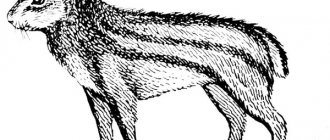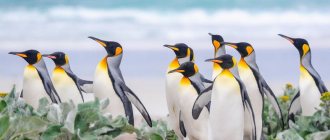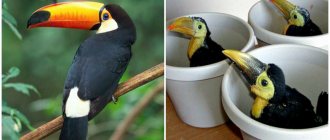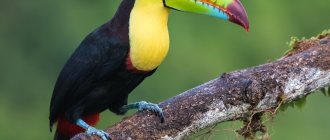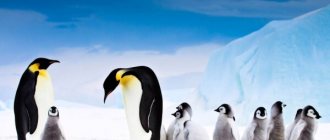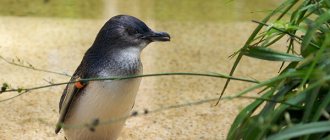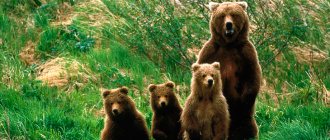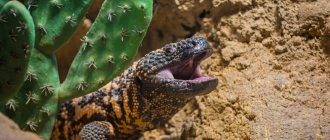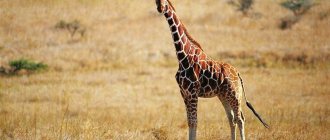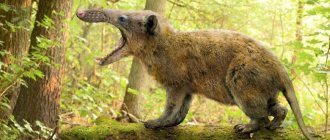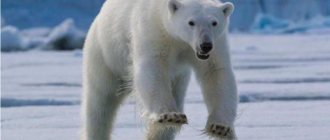A penguin is a flightless bird that belongs to the order Penguinidae, family Penguinidae (Spheniscidae).
The origin of the word “penguin” has 3 versions. The first involves a combination of the Welsh words pen (head) and gwyn (white), which originally referred to the now extinct great auk. Due to the similarity of the penguin with this bird, the definition was transferred to it. According to the second option, the name of the penguin was given by the English word pinwing, which translated means “hairpin wing.” The third version is the Latin adjective pinguis, meaning “fat.”
Penguin - description, characteristics, structure
All penguins can swim and dive excellently, but they cannot fly at all. On land, the bird looks rather clumsy due to the structural features of the body and limbs. The penguin has a streamlined body shape with highly developed muscles of the pectoral keel, which often makes up a quarter of the total mass. The penguin's body is quite plump, slightly compressed laterally and covered with feathers. The not too large head is located on a mobile, flexible and rather short neck. The penguin's beak is strong and very sharp.
As a result of evolution and lifestyle, the penguin's wings have changed into elastic flippers: when swimming underwater, they rotate in the shoulder joint like a screw. The legs are short and thick, have 4 toes, connected by swimming membranes.
Unlike other birds, the penguin's legs are significantly moved back, which forces the bird to keep its body strictly vertical while on land.
To maintain balance, the penguin is helped by a short tail, consisting of 16-20 hard feathers: if necessary, the bird simply leans on it, as if on a stand.
Photo by: John Kendrick
The penguin's skeleton does not consist of hollow tubular bones, which is usual for other birds: the structure of the penguin's bones is more reminiscent of the bones of marine mammals. For optimal thermal insulation, the penguin has an impressive reserve of fat with a layer of 2-3 centimeters.
The plumage of penguins is dense and dense: individual small and short feathers cover the body of the bird like a tile, protecting it from getting wet in cold water. The color of the feathers in all species is almost identical - a dark (usually black) back and a white belly.
Once a year, a penguin molts: new feathers grow at different rates, pushing out the old feather, so the bird often has an unkempt, ragged appearance during the molting period.
During molting, penguins are only on land, try to hide from gusts of wind and eat absolutely nothing.
penguin feather
Penguin molt. Photo by: Paul North
The sizes of penguins differ depending on the species: for example, the emperor penguin reaches 117-130 cm in length and weighs from 35 to 40 kg, and the little penguin has a body length of only 30-40 cm, while the penguin weighs 1 kg.
In search of food, penguins are able to spend quite a lot of time under water, plunging into its thickness to 3 meters and covering distances of 25-27 km. The speed of a penguin in water can reach 7-10 km per hour. Some species dive to depths reaching 120-130 meters.
During the period when penguins are not preoccupied with mating games and caring for their offspring, they move quite far from the coast, swimming out to sea at a distance of up to 1000 km.
On land, when it is necessary to move quickly, the penguin lies on its belly and, pushing off with its limbs, quickly slides along the ice or snow.
With this method of movement, penguins reach speeds of 3 to 6 km/h.
The lifespan of a penguin in nature is 15-25 years or more. In captivity, with ideal bird maintenance, this figure sometimes increases to 30 years.
Description of the bird
Photo of a penguin with chicks
All penguins have a streamlined body shape, well-developed muscles and wings that act like propellers under water. The keel is clearly defined on the sternum. The feet are large and short with a swimming membrane: on land, penguins often rest standing on their heels; the rigid plumage of the tail also serves as support for them. Penguins have a very short tail, since their steering function is performed by their legs, unlike other seabirds.
— Advertising —
The plumage of most species on the back is grayish-blue, which turns into black, and the belly is white. This color serves as a good camouflage for penguins. The cubs are gray or brown, sometimes with white sides and belly.
Penguins change plumage after hatching eggs and raising young. During the molting period, birds shed many feathers at once and become unable to swim, which is why they are deprived of the opportunity to obtain food for themselves until new feathers grow.
All penguins have a thick layer of fat, 2-3 cm, above which there are three layers of feathers: short, dense, waterproof. This reliable thermal insulation protects birds from exposure to extreme temperatures in their habitats.
Beneath the surface of the water, penguins make virtually no sounds; on land, they communicate using cries that are similar to the sounds of trumpets and rattles.
Enemies of penguins in nature
Unfortunately, the penguin has enemies in its natural habitat. Seagulls happily peck at penguin eggs, and helpless chicks are a tasty prey for skuas. Fur seals, killer whales, leopard seals and sea lions hunt penguins in the sea. Sharks will not refuse to diversify their menu with a plump penguin.
penguins-3994532_1920.jpg
Photo from pixabay.com
Phenology is the science of seasonal natural phenomena, the timing of their occurrence and the reasons that determine these timings. Thanks to the portal of the Russian Geographical Society “Phenological Network”, everyone has the opportunity to mark their observations on the map, add characteristics of the place, type of phenomenon, description, photographs, and even assess the condition of the natural object. The information collected from users from different regions is of great scientific value, especially taking into account the long history of phenological observations of the Russian Geographical Society, conducted since 1848.
What do penguins eat?
Penguins eat fish, crustaceans, plankton and small cephalopods. The bird happily eats krill, anchovies, sardines, Antarctic silverfish, small octopuses and squid. During one hunt, a penguin can make from 190 to 800-900 dives: this depends on the type of penguin, climatic conditions and food needs. The bird's mouthparts work on the principle of a pump: through its beak it sucks in small prey along with water. On average, birds swim about 27 kilometers during feeding and spend about 80 minutes a day at a depth of more than 3 meters.
penguin-1196947_1920.jpg
Photo from pixabay.com
What do penguins eat?
As waterfowl creatures, the main penguin diet includes fish and crustaceans, which the birds eat right under water. Each type has its own taste preferences. For example, emperor and Adélie penguins love krill, while other species prefer to feed on fish. To get a sufficient amount of mollusks and crustaceans, animals can make up to 900 dives, spending a huge amount of energy and effort on this.
Penguins also have a kind of food asceticism. It occurs during the molting period, which usually lasts from one to three months. At this time, the birds are forced to completely stop eating, losing up to half their body weight and using energy from previously accumulated fat reserves. Some species of penguins continue to starve while hatching their chicks. This process is facilitated by the fact that in this process females and males replace each other. Thanks to this, the spouses alternately “leave” for lunch.
Where do penguins live?
The geographical distribution of these birds is quite extensive, but they prefer cool conditions. Penguins live in cold zones of the Southern Hemisphere; their concentrations are mainly observed in Antarctica and the Subantarctic region. They also live in southern Australia and South Africa, are found almost along the entire coastline of South America - from the Falkland Islands to the territory of Peru, and near the equator they live in the Galapagos Islands.
Does a penguin have fur or feathers?
The skin of these amazing waterfowl is covered with many black and white feathers. They protect them from predators, for example, from leopard seals or killer whales, which, while hunting, are very often unable to distinguish the white color on the penguin’s belly from the light surface of the water surrounding it. If, on the contrary, the leopard looks from an elevated position, then it may well confuse the black back of the bird with the darkness of the ocean. Therefore, for their own safety, the penguins must wear these white and black tuxedos. Feathers grow over the entire surface of their body, which distinguishes these birds from other species in which they are located in strictly defined places.
Classification of the Penguin family (Spheniscidae)
The order Sphenisciformes includes the only modern family - Penguins, or Penguins (Spheniscidae), in which 6 genera and 18 species are distinguished (according to the datazone.birdlife.org database from November 2018).
Genus Aptenodytes JF Miller, 1778 - Emperor penguins
- Aptenodytes forsteri R. Gray, 1844 - Emperor penguin
- Aptenodytes patagonicus F. Miller, 1778 - King Penguin
Genus Eudyptes Vieillot, 1816 - Crested penguins
- Eudyptes chrysocome (JR Forster, 1781) - Crested penguin, golden-crested rock penguin
- Eudyptes chrysolophus (JF von Brandt, 1837) - Golden-haired penguin
- Eudyptes moseleyi Mathews & Iredale, 1921 - Northern crested penguin
- Eudyptes pachyrhynchus R. Gray, 1845 - Victoria penguin
- Eudyptes robustus Oliver, 1953 - Snar's crested penguin
- Eudyptes schlegeli Finsch, 1876 - Schlegel's Penguin
- Eudyptes sclateri Buller, 1888 - Great crested penguin
Genus Eudyptula Bonaparte, 1856 - Little penguins
- Eudyptula minor (JR Forster, 1781) - Lesser penguin
Genus Megadyptes Milne-Edwards, 1880 - Magnificent Penguins
- Megadyptes antipodes (Hombron & Jacquinot, 1841) - Yellow-eyed penguin, or magnificent penguin
Genus Pygoscelis Wagler, 1832 - Chinstrap penguins
- Pygoscelis adeliae (Hombron & Jacquinot, 1841) - Adelie Penguin
- Pygoscelis antarcticus (JR Forster, 1781) - Chinstrap penguin
- Pygoscelis papua (JR Forster 1781) - Gentoo (subantarctic) penguin
Genus Spheniscus Brisson, 1760 - Spectacled penguins
- Spheniscus demersus (Linnaeus, 1758) - Spectacled penguin
- Spheniscus humboldti Meyen, 1834 - Humboldt penguin
- Spheniscus magellanicus (JR Forster, 1781) - Magellanic penguin
- Spheniscus mendiculus Sundevall, 1871 - Galapagos penguin
Features of character and lifestyle
Photo: King Penguins
King penguins are friendly towards people, showing an interest in naturalists. They live in large flocks, standing close to each other in winter to maintain warmth. During the periods of breeding and puberty, penguins become aggressive towards each other. They form pairs that occupy a certain small area in the flock’s habitat. And each pair wants to occupy as much territory as possible, which is why the penguins begin to fight.
Usually fights go quickly - the injured penguin loser is quickly removed from the battlefield. But sometimes they lead to death, since the penguin can injure its opponent’s head with its strong beak. During the breeding season, from a thousand to 500 thousand individuals gather on the territory. But king penguins spend most of their time in the water, diving to great depths. On land they move on their bellies, gliding along the ice. The tail in such a situation acts as a rudder. On their paws they move slowly, waddle, swaying from side to side.
There is no hierarchy in a flock of penguins. They lack leaders, dominant females and weak or strong males. Grown penguins do not form new flocks, but remain in this group, making it even more numerous. Penguins are capable of reaching speeds of up to 15 km/h in water, diving up to 300 m in depth. On average, they hold their breath for up to five minutes and then rise to the surface to breathe—they do this up to 150 times a day.
Types of penguins, photos and names
The modern classification of penguins includes 6 genera and 19 species. Below are descriptions of several varieties:
- Emperor penguin (Aptenodytes forsteri)
This is the largest and heaviest penguin: the weight of the male reaches 40 kg with a body length of 117-130 cm, females are somewhat smaller - with a height of 113-115 cm they weigh on average 32 kg. The plumage on the back of the birds is black, the belly is white, and in the neck area there are characteristic spots of orange or bright yellow. Emperor penguins live on the coast of Antarctica.
- King penguin (Aptenodytes patagonicus)
very similar to the emperor penguin, but differs from it in its more modest size and feather color. The size of the king penguin varies from 90 to 100 cm. The weight of the penguin is 9.3-18 kg. In adult individuals, the back is dark gray, sometimes almost black, the abdomen is white, and there are bright orange spots on the sides of the dark head and in the chest area. The habitats of this bird are the South Sandwich Islands, Tierra del Fuego Islands, Crozet, Kerguelen, South Georgia, Macquarie, Heard, Prince Edward, and the coastal waters of Lusitania Bay.
- Adelie penguin (Pygoscelis adeliae)
medium sized bird. The penguin is 65-75 cm long and weighs about 6 kg. The back is black, the belly is white, the distinctive feature is a white ring around the eyes. Adélie penguins live in Antarctica and the adjacent island territories: Orkney and South Shetland Islands.
- Northern crested penguin (Eudyptes moseleyi)
endangered species. The length of the bird is approximately 55 cm, the average weight is about 3 kg. The eyes are red, the belly is white, the wings and back are gray-black. Yellow eyebrows blend smoothly into tufts of yellow feathers located to the side of the eyes. Black feathers stick out on the penguin's head. This species differs from the southern crested penguin (lat. Eudyptes chrysocome) by shorter feathers and narrower eyebrows. The bulk of the population lives on the islands of Gough, Impregnable and Tristan da Cunha, located in the southern Atlantic Ocean.
Photo credit: Brian Gratwicke
- Golden-headed penguin (golden-haired penguin) (Eudyptes chrysolophus)
has the typical coloring of all penguins, but differs in one feature in appearance: this penguin has a spectacular tuft of golden feathers above its eyes. Body length varies between 64-76 cm, maximum weight is a little over 5 kg. Golden-haired penguins live along the southern shores of the Indian Ocean and the Atlantic, are slightly less common in the northern part of Antarctica and Tierra del Fuego, and nest on other islands of the Sub-Antarctic.
Photo by: Butterfly voyages - Serge Ouachée
- Gentoo penguin (Pygoscelis papua)
the largest penguin in size after the emperor and king. The length of the bird reaches 70-90 cm, the weight of the penguin is from 7.5 to 9 kg. The black back and white belly are the typical color of birds of this species; the beak and legs are colored orange-red. The penguins' habitat is limited to Antarctica and the islands of the Subantarctic zone (Prince Edward Island, South Sandwich and Falkland Islands, Heard Island, Kerguelen, South Georgia, South Orkney Islands).
Photo by: Jerzy Strzelecki
- Magellanic penguin (Spheniscus magellanicus)
has a body length of 70-80 cm and a weight of about 5-6 kg. The color of the plumage is typical for all penguin species, the peculiarity is 1 or 2 black stripes in the neck area. Magellanic penguins nest on the Patagonian coast, on the Juan Fernandez and Falkland Islands, and small groups live in southern Peru and Rio de Janeiro.
- Chinstrap penguin (Pygoscelis antarctica)
reaches a height of 60-70 cm and weighs no more than 4.5 kg. The back and head are dark gray, the penguin's belly is white. A black stripe runs down the head. Chinstrap penguins live on the coast of Antarctica and the islands adjacent to the continent. They are also found on icebergs in Antarctica and the Falkland Islands.
Photo by: Greg Lasley
- Spectacled penguin, also known as donkey penguin, black-footed penguin or African penguin (Spheniscus demersus)
reaches a length of 65-70 centimeters and weighs from 3 to 5 kg. A distinctive feature of the bird is a narrow black stripe, bending in the shape of a horseshoe and running along the belly - from the chest to the paws. The spectacled penguin lives on the coast of Namibia and South Africa, nesting along the coastline of islands with the cold Bengal Current.
Photo by: Awie Badenhorst
- Little penguin (Eudyptula minor)
the smallest penguin in the world: the bird is 30-40 cm tall and weighs about 1 kg. The back of the small penguin is colored blue-black or dark gray, the chest area and the upper part of the legs are white or light gray. Penguins live on the coast of South Australia, Tasmania, New Zealand and the adjacent islands of Stuart and Chatham.
Photo credit: JJ Harrison
The smallest penguin in the world. Photo by: Fir0002
Emperor penguin chick hatching in winter
This is surprising, but living in harsh conditions, emperor penguins breed in winter, when other birds move from these places to warmer ones. The female lays only one egg, which the male hides from the cold in the abdominal fold. The male remains in the colony, and the female goes to the sea to feed. When a chick is born in the middle of winter, the returning female feeds it with semi-digested food stored in the stomach. The male, who by this time has lost more than half his weight, hands the chick to the mother and goes to sea himself, where he spends a month and a half. It should be noted that the chick hatches from the egg naked and then grows feathers within a few weeks.
Penguin breeding
Penguins are communal birds. In the water element they live in flocks; on land they form colonies, the number of individuals in which reaches several tens and even hundreds of thousands. All members of the penguin family are monogamous and form permanent pairs.
The readiness to mate and hatch offspring in penguins depends on the species and gender. Typically, males mature later than females, some species are ready to have penguins at the age of 2 years, other species of penguins begin to think about offspring a year later, and still others become parents only at the age of five (for example, golden-haired penguins).
During the mating season, males make rather loud sounds, reminiscent of the sound of a trumpet, trying to attract the attention of females.
Penguins most often nest on low rocky shores, while some species make primitive nests from pebbles and sparse vegetation, while others prefer cavities in the rocks.
Photo by: Ralph Grizzle
Usually 2 eggs appear in a clutch, sometimes one, very rarely - three. The penguin egg is white or slightly greenish in color. Both parents incubate the eggs, replacing each other during absences to forage for food. The incubation period lasts from 30 to 100 days depending on the type of bird.
Penguin chicks hatch blind, with thick down on their bodies, and only gain sight after a couple of weeks. The weight of a newborn penguin varies depending on the species and can reach 300 grams. Despite the care of their parents, more than 60% of the chicks die from hunger, low temperatures and attacks by skuas.
Photo: Chester Zoo
For approximately 20 days, penguin chicks are under constant care, but after three weeks of care, the parents leave their babies, only occasionally bringing them food. This factor leads to the fact that slightly older penguin chicks begin to unite in groups, which scientists call “kindergartens” or “nurseries”.
Often the period of formation of such “nurseries” occurs at a time when immature penguins or birds, which for some reason have lost their clutches, return to the colony from sea voyages. These individuals are actively involved in caring for the young, participate in their feeding and protect them from predatory skuas, thereby increasing the survival rate of the still defenseless chicks.
Photo by: Reina del Sur
Until the first moult, penguin chicks are exclusively on land, plunging into water for the first time only with the appearance of thick, almost waterproof plumage.
Reproduction and raising of offspring
Penguins are among the monogamous birds that form a pair once and for all, and this process, in turn, is preceded by a long courtship procedure. Penguin nesting sites are often several hundred kilometers away from the water. When they return after long trips to their native places, the penguins begin mating games and the courtship period. At the same time, the spouses easily find each other, despite the large size of the colony where the penguins prefer to live.
Even if the previous partner has already entered the mating season with a new female or male, when the previous “spouse” is announced, the new family union is dissolved.
Recommended by topic
Blackbirds Woodpecker Heron
The courtship period for penguins lasts quite a long time - about three weeks. At this time, penguins can begin to stretch their necks in the manner of swans and perform “serenades” that do not stop either during the day or at night. Also, a characteristic behavior for newly formed couples is the desire to sit opposite each other with their eyes closed for a long time.
During courtship, some males strive to give a gift to their chosen one, which will be useful during the future construction of the nest. Such a gift can be small stones, which the male places at the feet of his future wife. If his chosen one accepts this gift, then the couple begins to build a nest together. To do this, they surround the dug hole with stones and make sure that neighbors do not steal their equipment.
In penguin families, after a long period of courtship of almost a month, from one to three eggs appear. Typically, incubation of eggs lasts about a month, but in some species of penguins this process can take up to 66 days.
The appearance of the egg is greeted with exclamations of joy, which are reminiscent of human joy at the arrival of a long-awaited event. Caring for the emerging egg becomes the responsibility of the father.
So, for example, in some species of penguins that do not build nests, after a few hours the female transfers the laid egg from her paws to the paws of the male, which he accepts with a special ceremony: he bows, flaps his wings, shakes his tail, demonstrating joyful excitement at the appearance of future offspring.
After this, the male, using his beak, rolls the egg onto his paws and covers it on top with a fat fold. This “pocket” creates a warm atmosphere for the egg, preventing it from falling out even during active movements. While the father is busy guarding the egg, he cannot eat anything, since all his attention is focused on caring for the offspring.
While the father is busy guarding the egg, he cannot eat anything, since all his attention is focused on caring for the offspring.
The female who transferred the egg goes to the water to fully feed on the fish. Parental paternal instinct helps her to be confident that nothing will happen to her offspring during her absence. Subsequently, the female returns to her chosen one, who incubates the egg for 1-2 months until a fluffy newborn chick is born.
Question to the expert
Question: Why don't penguins freeze?
Despite the fact that the average annual temperature at the South Pole is 49.3°C and wind speeds reach 100 m/s, penguins are extremely resistant to cold, which is explained by their anatomy. Thus, a thick layer of fat and the presence of water-repellent feathers help birds keep warm. The air between the feathers makes it possible to retain heat in water and on land, and the penguin's body is well protected from getting wet. Penguins' paws are saved from freezing using a special method of blood circulation, in which hot arterial blood from the paws shares heat with oncoming venous blood, which is realized due to the unusual arrangement of veins and arteries in the body of penguins. Additionally, some species of penguins, such as emperor penguins, huddle in groups to stay warm. The temperature in such a group can reach +35 °C, even though it is around -20 °C.
Caring for chicks
The father continues to hold the newly born baby on his paws and keep him warm. However, now a new stage of the program aimed at caring for the baby comes into force - the need to find food to ensure its survival. This stage lasts until the return of the spouse, who may be absent for several dozen days. After her return, the male goes off to feed on his own.
Until the mother returns, the father feeds the chicks independently. “Milk” is formed in his stomach and esophagus, resembling porridge. It turns out to be extremely nutritious due to its high fat content, which is 8 times higher than that of cow's milk.
After the thin and exhausted fathers go in search of food and hand over the chicks to their mothers, the females transfer them to a down pocket. After this, the babies are fed for 2-3 weeks due to the fact that their mothers remove their stomachs in parts. Typically this food consists of small crustaceans and fish. Until the male returns, the females feed the chicks almost every hour with food, and then supplement them with “milk”.
Penguins, being collective birds, form a kind of “kindergarten” in which all adult birds are occupied, including those that do not have offspring. In this case, they take on the role of guarding and protecting the young from unforeseen situations, and also establish order in the team. This helps keep all the babies in one place so they can be easier to keep an eye on.
Penguins go to this kind of “kindergarten” from the age of five weeks, when they are already quite large and no longer fit in their mother’s pocket. The organization of such a kindergarten is convenient for a number of reasons. Firstly, this way parents can go out and get prey to continue feeding their children. Upon returning, they easily find their cubs among thousands of others by their special timbre of voices and screams. Hungry kids greedily swallow their portion of food, having become hungry during the long period of absence of the parent. Secondly, this approach helps protect penguins from the cold, as they gather in large and dense groups, which allows penguins to warm each other even at the lowest temperatures.
Penguin Kindergarten
From the age of five months, the offspring is considered old enough to no longer need parental care. So, with the arrival of summer, when the ice floes melt, penguins dress up in their downy outfit and go to practice in the sea. Parents also come there, trying to support their offspring.
Strong young penguins set off for independent practice only at the beginning of next winter. At this time, they are considered strong enough to hunt on their own and adapted enough to cope with the harsh conditions of their habitat.
Do they eat penguins?
It is difficult to give a definite answer to such a question. Today, a person is unlikely to decide on such a delicacy, although in extreme conditions anything can happen. According to some reports, some peoples inhabiting the Antarctic territory include dishes made from penguin meat in their menu.
Confirmed evidence of the consumption of penguin meat is information in the book “Antarctic Odyssey” by author R. Priestley. It describes in detail the hunting of penguins by members of the expedition in order not to die of hunger due to lack of food. True, this happened quite a long time ago, at the beginning of the twentieth century, and was caused by unforeseen circumstances, when the duration of the expedition unexpectedly increased. According to its participants, penguin breast was valued for its nutritional value due to its fat content and had a good taste.
Why don't penguins fly?
To understand why penguins don’t fly, it’s enough to see them underwater, because that’s where they spend most of their lives, getting their food: fish and shellfish. The short wings of penguins turn into powerful fins and allow them to move underwater at high speed, and their funny paws and tail become an excellent rudder. Gentoo penguins are the fastest among the rest because they can swim at speeds of up to 30 kilometers per hour.
Interesting facts about the penguin
- Among the penguins there are record swimmers: gentoo penguins reach speeds in the water of up to 32-36 km/h.
- The Magellanic penguin got its name thanks to the famous traveler who discovered an unusual flightless bird in 1520 near the island of Tierra del Fuego.
- On land, the penguin is very clumsy and quite often, throwing its head back sharply, loses its balance and falls on its back. The bird can no longer rise from such a position on its own, so at many polar stations an amazing profession has appeared - penguin lifter, or penguin turner. This person helps the penguins turn over and take the bird’s usual upright position.
Did you like the article? Share with your friends:
izobrazhenie_barbara_dougherty_s_sayta_pixabay_-emperor-penguins-2821897_1920.jpg
Photo from pixabay.com
How to learn more about penguins?
Traditionally, photo exhibitions, lectures, master classes and documentary film screenings are held around the world on Penguin Awareness Day. Similar themed events will be held on April 25, World Penguin Day.
One of these events will take place at the Darwin Museum. Guests of the holiday will go on a real Antarctic expedition. They will get acquainted with the geography and history of the discovery of Antarctica, its unique inhabitants, and gain the skills necessary for polar explorers. The holiday will take place on February 1st.
In the meantime, you can test your knowledge about these unusual and charming birds by taking a test from the Russian Geographical Society and the Phenological Network of the Russian Geographical Society .
